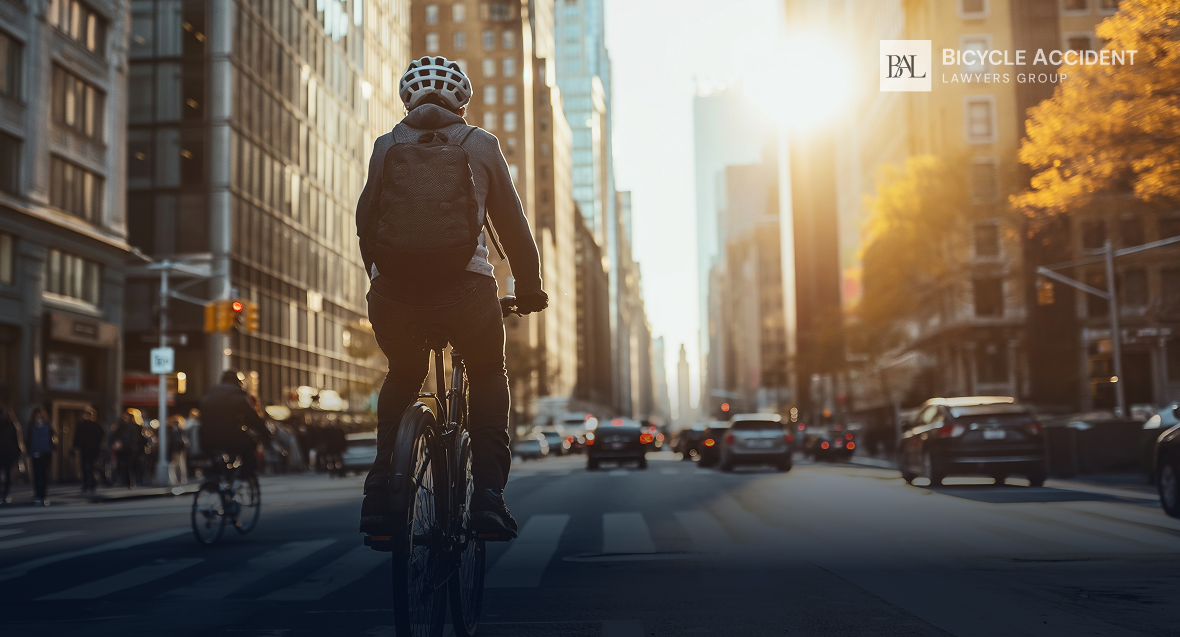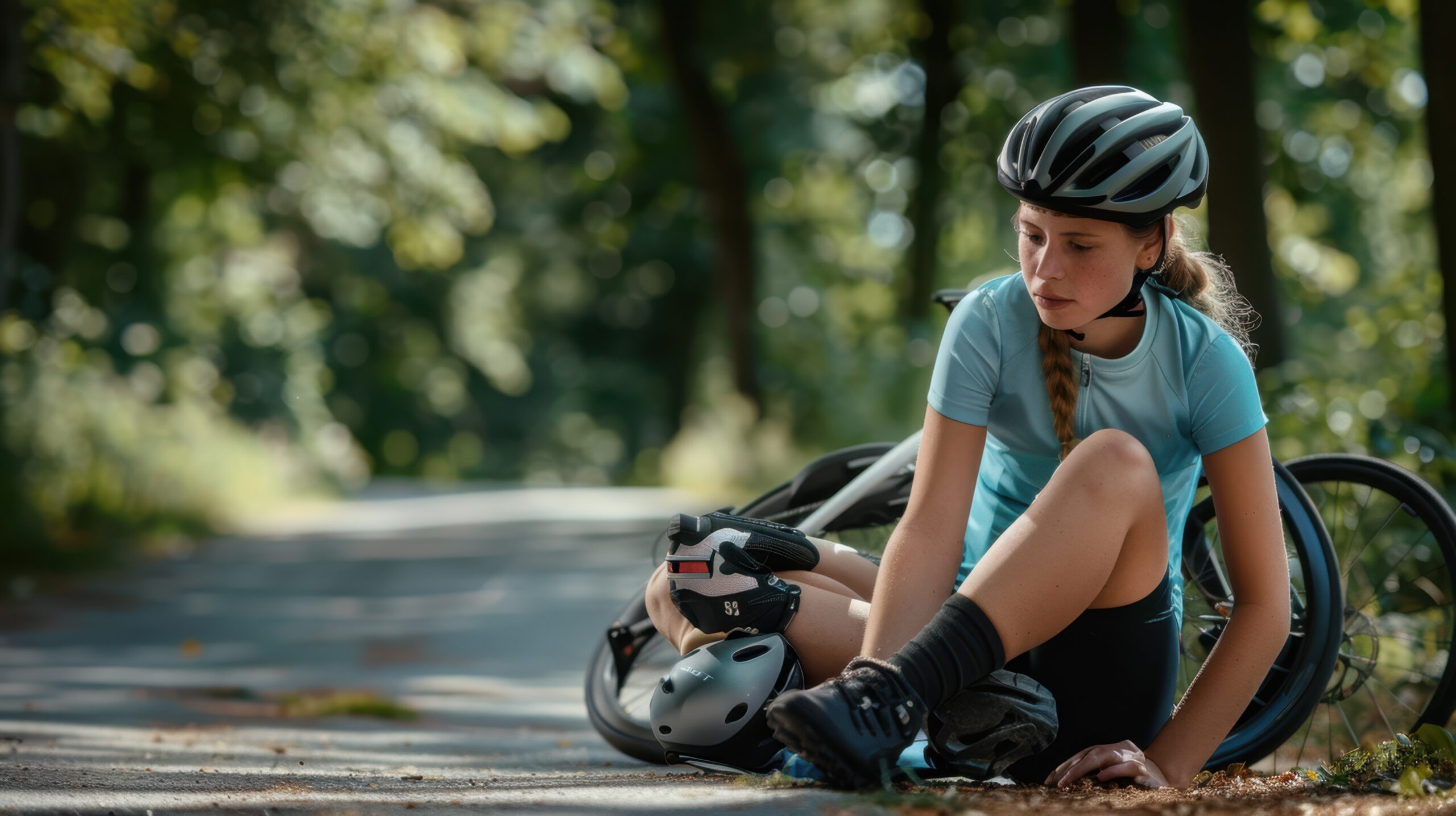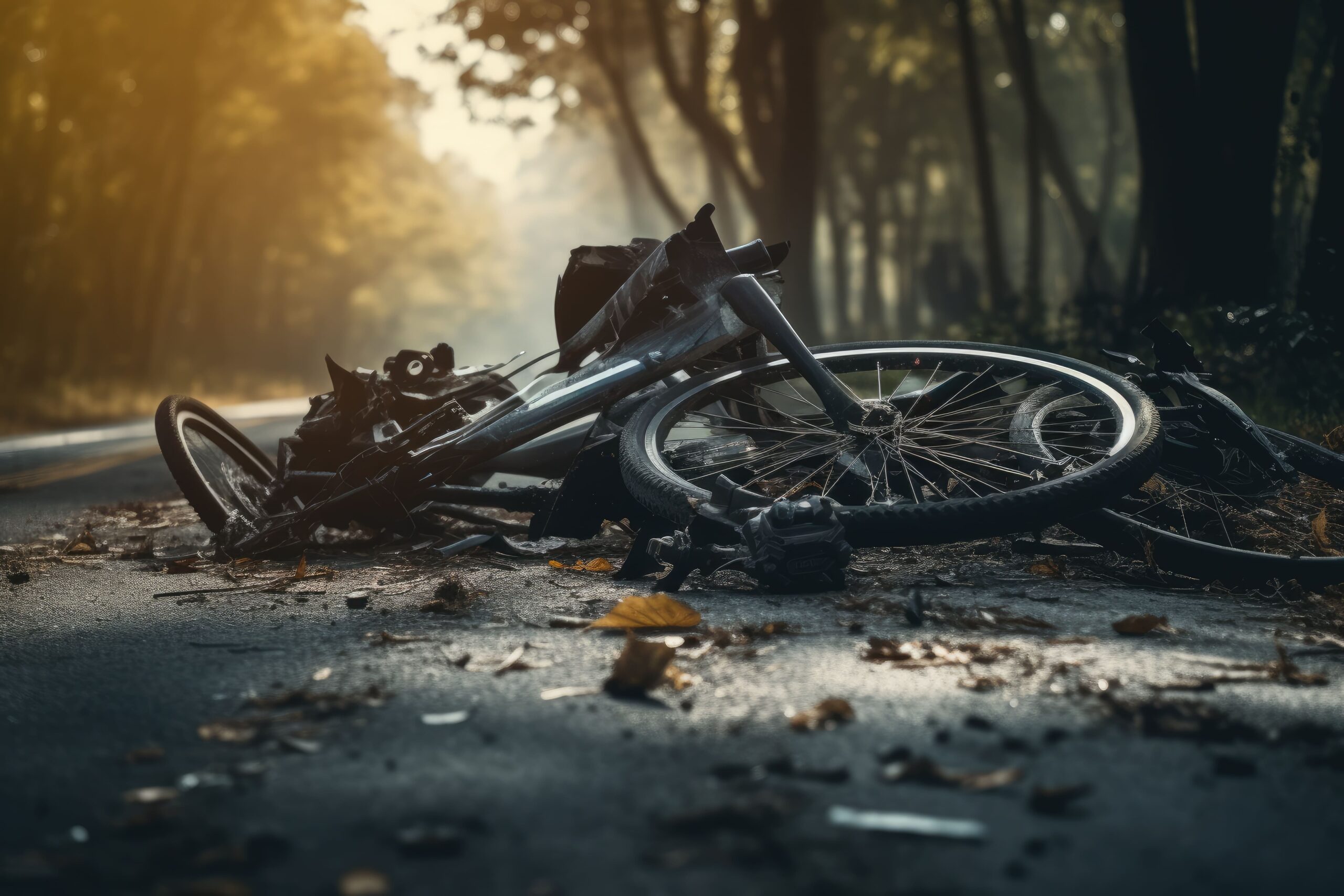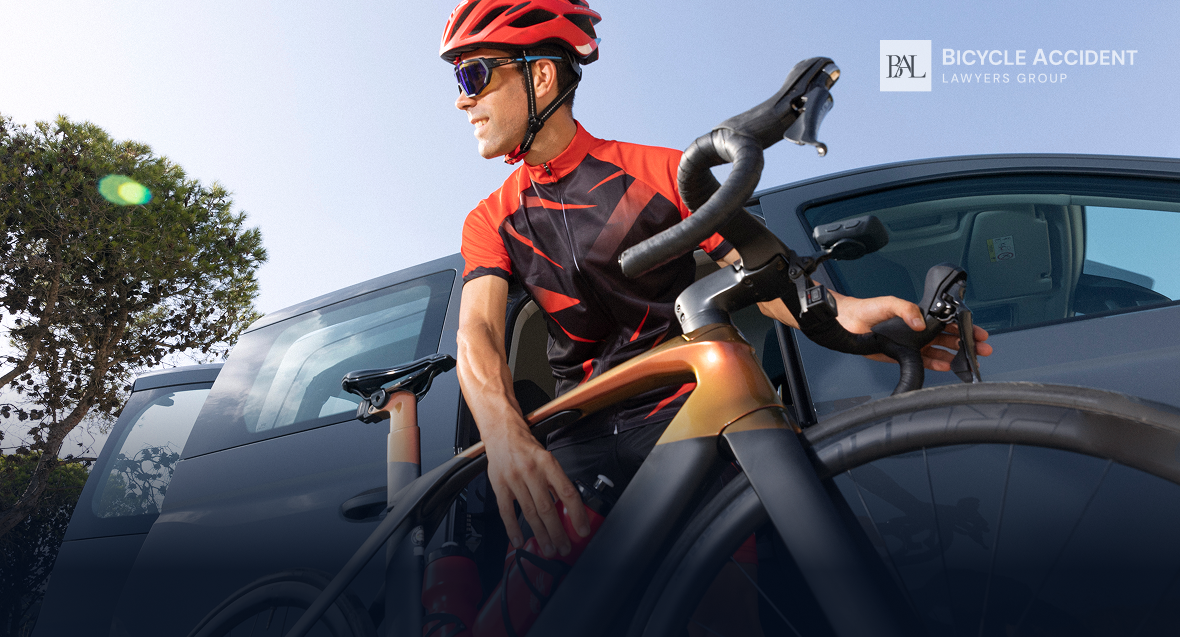Almost 2 million adult New Yorkers ride a bike occasionally, and over a third of the people riding bicycles in the city do so on a daily basis, according to NYC DOT. Such an interest in the activity motivated local authorities to invest in improved cyclists’ safety, biking infrastructure, and education.
However, recent US bicycle accident statistics state that 24 people lost their lives in bicycle accidents in 2024, and over 5K sustained severe injuries. Many incidents occurred because of traffic errors, inattention, and, most importantly, a lack of legal knowledge.
New York City and the state have a variety of traffic laws concerning bicyclist safety. A better understanding of local bike laws will help you protect your rights and secure maximum compensation for the losses inflicted by a negligent party should an incident occur.
Key Bicycle Laws in NYC
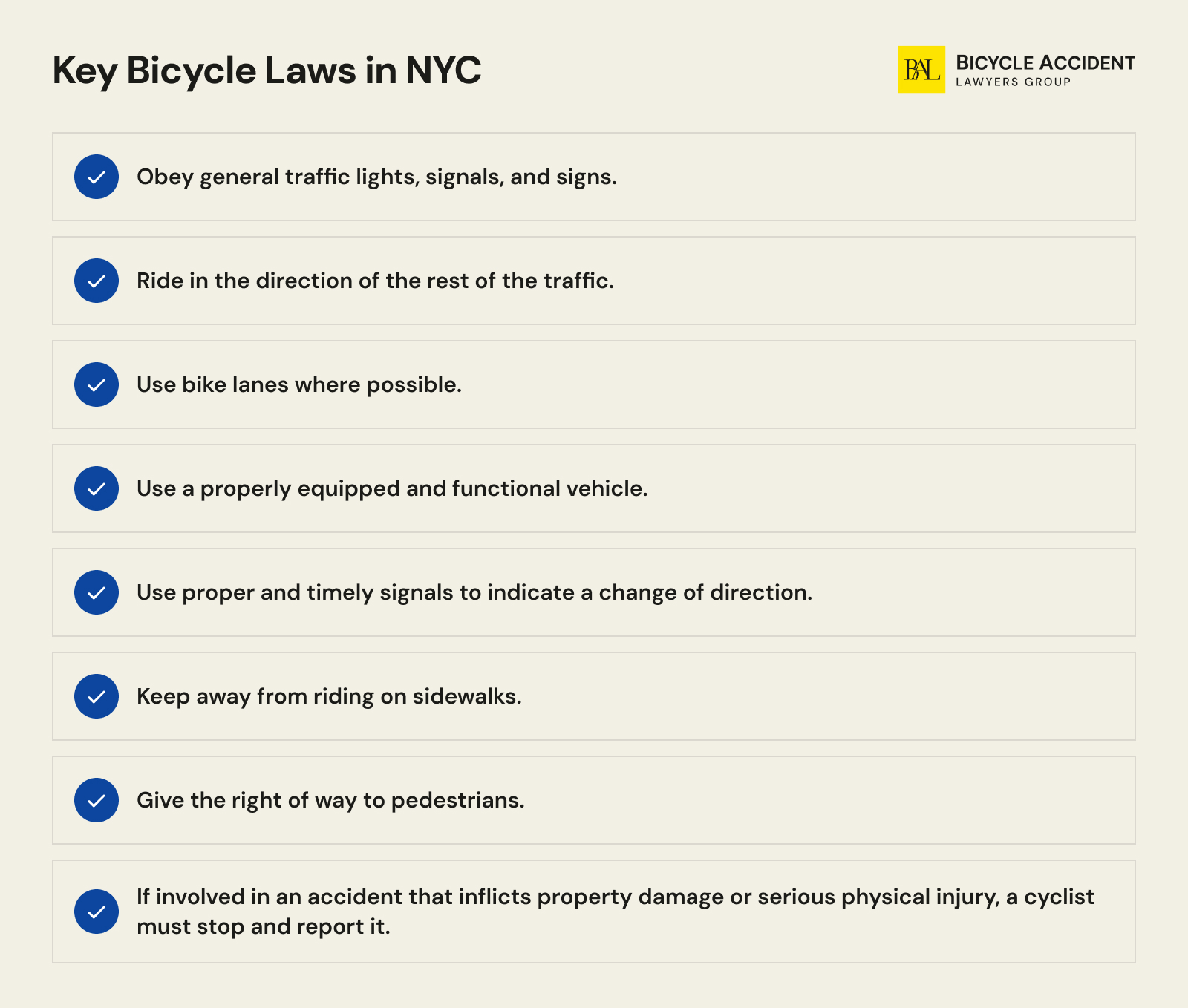
Whether you bike to work every day or go for an occasional ride to explore the city, you have to abide by a few vital biking laws:
- Obey general traffic lights, signals, and signs.
- Ride in the direction of the rest of the traffic.
- Use bike lanes where possible.
- Use a properly equipped and functional vehicle.
- Use proper and timely signals to indicate a change of direction.
- Keep away from riding on sidewalks.
- Give the right of way to pedestrians.
- If involved in an accident that inflicts property damage or serious physical injury, a cyclist must stop and report it.
Why Do These Rules Apply to Cyclists?
Bicycle laws in New York State, as well as in the city, are designed to promote enhanced safety of vulnerable road users and regulate the overall traffic flow. Bike riding laws are defined in the NY Vehicle and Traffic Law (VTL) and the Rules of the City of New York (RCNY). For example:
- According to VTL § 1231, all traffic laws apply to cyclists.
- New York City traffic rules and regulations apply to all road users, including bike riders, and RCNY § 4-02(a) proves it.
- Another rule, RCNY § 4-12 (h), dictates the precise course of action to take after an accident.
- According to the RCNY § 4-12 (p) rule, all cyclists in the city must use bike lanes where available.
- The § 19-176 rule forbids riding on the sidewalks in the city.
Failure to comply with these cycling laws can create dangerous situations on the road or even lead to a serious incident.
Safe Passing Laws

Usually, accidents involve several parties. That is why all road users, including but not limited to drivers and bike riders, must be aware of and adhere to so-called safe passing laws. In New York City, the following safe passing rules apply:
- Duty of care: Section 1146 of the VTL of New York stresses that all drivers must be exceptionally careful not to get into an incident involving a cyclist.
- Safe distance: According to Section 1122 of the VTL of NYC, motor vehicles have to pass cyclists and other road users moving in the same direction on the left. A safe distance must be preserved. Although there isn’t an official definition of what distance is deemed safe, there should be enough room left for the rider to maneuver.
- Side of the road: Traffic laws of New York determine that all vehicles must drive or ride as close to the right side of the road as possible. Section 1120 has a few exceptions, which are primarily applicable to situations when you need to pass or overtake a vehicle moving in the same direction.
- Penalties: According to Section 19-190 of RCNY, any party guilty of a traffic collision will be subjected to a rightful penalty.
Dooring Laws
A dooring incident implies that a driver or passenger opens a car door into a traffic lane without checking for an approaching rider. Although it may seem like an easy obstacle to avoid, one should not underestimate the negative potential of a dooring bicycle accident. In fact, around 1,700 injured cyclists get hurt enough in such accidents to seek medical treatment for the sustained injuries annually.
Considering the odds, local authorities of New York came up with a specific regulation — VTL 1214 — that mandates motor vehicle operators and their passengers to inspect the path before opening the door and getting out of the car.
Dooring by a NYC Taxi Cab
There are over 13K taxi cabs registered in New York, so it’s no wonder that they frequently get involved in traffic accidents. This also applies to dooring incidents. To reduce the risk of cyclists being hit by taxi passengers opening doors in New York City, local authorities introduced specific ordinances to address the issue.
- According to RCNY 4-11(c), taxi operators must stop and park their vehicles parallel to the curb but at least 12 inches away from it.
- Section 4-12 (c) of RCNY primarily refers to cab passengers and states that no taxi occupant can leave the car from the side facing an active lane without checking for approaching cyclists.
Right-of-Way Laws
The right of way is a law that dictates how all road users must act in situations when one person has to yield to another to avoid a dangerous traffic incident. For instance, motor vehicle operators owe the right of way to bicyclists, and cyclists, in turn, owe it to pedestrians.
When the responsible party fails to do as they are obliged and that leads to an accident, they will be held accountable for the damages and losses that the collision brings. However, sometimes it takes a legal background, evidence, and field experience to handle the case. So, to ensure the best outcome for your claim, it is always a great idea to consult a trained New York bicycle accident attorney as soon as possible.
Law Regulating Bicycles Passing on the Right
In New York City, bike riders are supposed to ride on the right side of the road, in the same direction as the rest of the traffic. That is why overtaking a vehicle on the right is generally forbidden. However, Section 1123 of the VTL of New York has a couple of exceptions when passing on the right is allowed:
- When the vehicle in front shows that they are about to make a left turn.
- When there is sufficient space on the lane for two or more lines of vehicles moving in each direction, and the space isn’t occupied by parked cars.
Even if these two conditions are preserved, persons riding bicycles must be exceptionally cautious when passing on the right. Moving vehicles aren’t the only threat to consider. You should remember that there may be hidden obstacles on the road, or pedestrians can step into the lane without warning, so you should always leave yourself enough time to react and make a safe maneuver.
Bike Lane Laws
A bicycle lane is a special space on the side of the road outlined by pavement markings, signs, and, sometimes, barriers for cyclists to navigate the city streets safely and without any disruption to the rest of the traffic. Usable bike lanes can also serve as in-line skate paths.
In New York, two major laws apply to using a bicycle lane:
- According to Section 4-12(p) of RCNY, cyclists shall always use a dedicated bike lane or path when available. Exceptions are possible when the rider has to make a turn or if there’s any obstruction on the way that has to be avoided.
- Even when on a bike lane, persons riding bicycles must travel in the direction of traffic. Riding against it is prohibited.
Bicycle Safety Equipment Laws
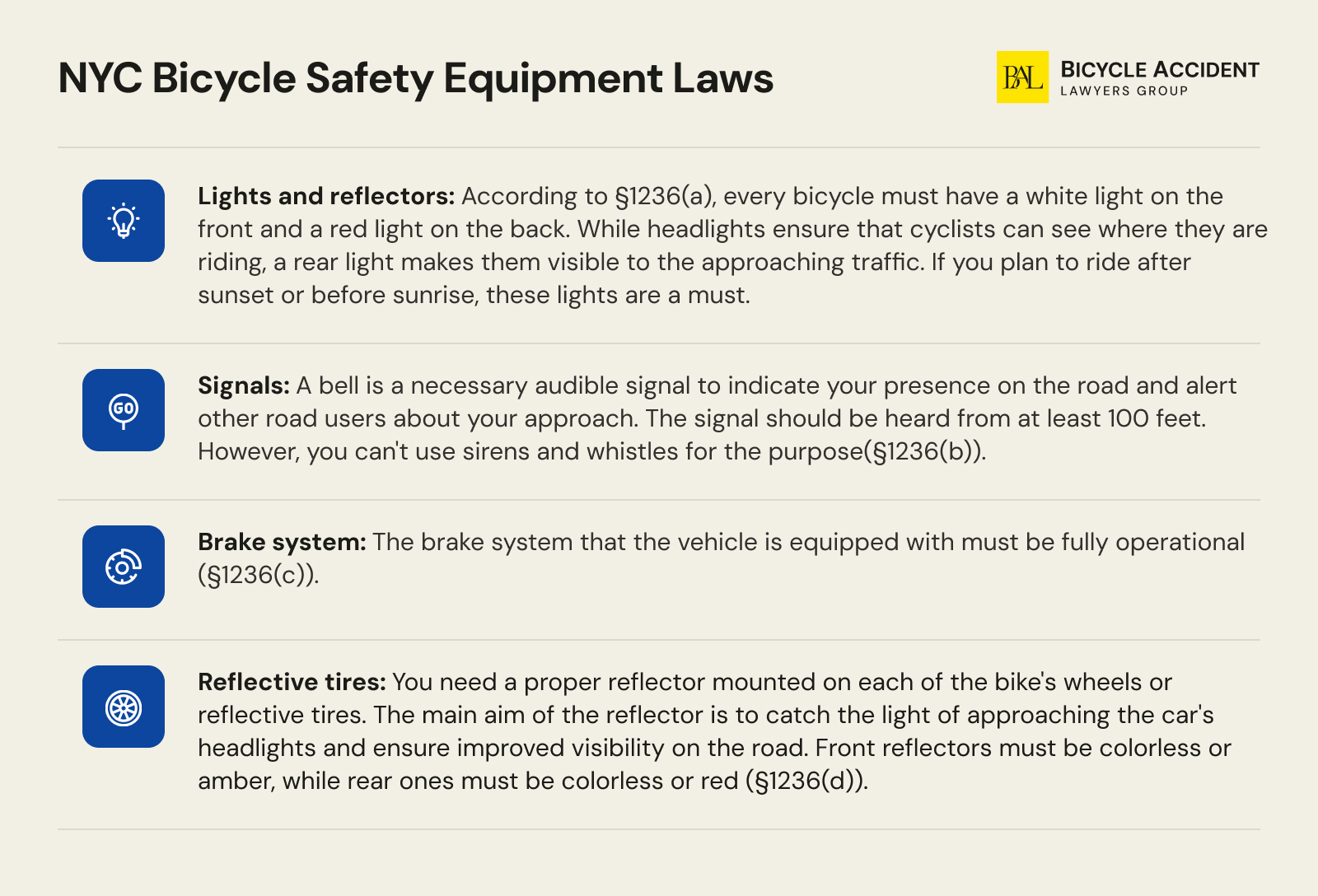
All bicycles ridden in the city must comply with local equipment safety requirements. They are defined by Section 1236 of the Laws of New York and include the following:
- Lights and reflectors: According to §1236(a), every bicycle must have a white light on the front and a red light on the back. While headlights ensure that cyclists can see where they are riding, a rear light makes them visible to the approaching traffic. If you plan to ride after sunset or before sunrise, these lights are a must.
- Signals: A bell is a necessary audible signal to indicate your presence on the road and alert other road users about your approach. The signal should be heard from at least 100 feet. However, you can’t use sirens and whistles for the purpose(§1236(b)).
- Brake system: The brake system that the vehicle is equipped with must be fully operational (§1236(c)).
- Reflective tires: You need a proper reflector mounted on each of the bike’s wheels or reflective tires. The main aim of the reflector is to catch the light of approaching the car’s headlights and ensure improved visibility on the road. Front reflectors must be colorless or amber, while rear ones must be colorless or red (§1236(d)).
Bicycle Helmet Laws in NY
According to Section 1238 of NY VTL, only children under 14 (whether riders or passengers) must wear a protective helmet. Otherwise, the parents or legal guardians may face a fine of up to $50. Protective helmets must comply with US Consumer Product Safety Commission (CPSC) standards.
Although adults aren’t legally required to wear a helmet while cycling in the city, it is highly advisable to wear one. Recent research proves that a quality helmet can reduce serious head injuries by 60% and decrease the number of killed or injured persons riding bicycles by 34%.
Riding on the Sidewalk, on Beaches, and in Parks in NYC
In New York City, according to RCNY § 4-07(c) (3), it is prohibited to ride on a sidewalk. If a cyclist violates the rule, they may receive a traffic ticket or even have their vehicle confiscated.
The situation with parks is slightly different. You may ride a bicycle in a park only if a designated bike lane is available. If no dedicated path exists nearby, you are permitted to walk your bike through the park (RCNY 4-07 (c) (3)). As for the beaches in NYC, cycling is prohibited there.
Riding Single File or No More Than 2 Abreast
The local jurisdiction of NYC has a set of specific regulations that concern how cyclists have to ride on roadways, shoulders, and bicycle lanes. The general rule, §1234, states that you should ride in a single file or no more than two abreast as close to the right-hand curb as possible when on the road.
However, persons riding bicycles on a designated bike lane or shoulder may ride two or more abreast. The only requirement is sufficient space available on such a shoulder or path.
Vehicles Obstructing Bicycle Lanes in New York
The main reason why usable bicycle lanes should be implemented in proper city infrastructure is to protect cyclists from the risks that riding on a road poses. The City of New York has banned motor vehicles from bicycle lanes, according to Section 4-12(p) of RCNY. There are a few exceptions, such as leaving or entering private or personal property and crossing intersections.
Cars are forbidden to stop and park in a designated bike lane (Section 4-08(e)(9)) unless it is an emergency or instruction from law enforcement.
Bicycle Seats and Pedals Laws
There are also a few major requirements for the manner in which cyclists should operate their vehicles. According to Section 1232 of the VTL of NYC, a bicyclist must ride on a permanent seat attached to the bike. Moreover, the rider’s feet should always be on the pedals. A single-person bicycle can’t be used to transport two or more persons unless it is specifically equipped for the purpose.
Bicycle Laws Regarding the Use of Earphones
In New York, a bike rider is permitted to use no more than one earphone at a time while en route. The VTL 375 24-a regulation is aimed at enhancing rider awareness while on the road. If you want to listen to an audio device while cycling, using a single earphone may help you prevent a serious bicycle accident with a motor vehicle or any other incident. This way, you will be able to hear traffic and react to an unexpected situation on time.
NYC Laws Regulating Children on Bikes
New York City authorities treat children’s safety exceptionally seriously. Section 1238 of VTL states the following:
- Infants under 12 months of age aren’t allowed as passengers on bikes.
- All children less than 14 years of age must wear protective helmets while riding bicycles.
- Children from 1 to 5 years old can ride as passengers in a properly affixed child carrier.
- Children under 12 can ride on sidewalks in New York as long as the wheels of their vehicles are less than 26 inches in diameter.
- Parents or legal guardians who fail to comply with these laws may receive a penalty in the form of a 50-dollar fine.
Conclusion
New York authorities have put a lot of thought and effort into compiling all-encompassing cycling laws to promote bicyclist protection in the city. Starting with the right-of-way regulations, sidewalk biking, and safety equipment, and ending with underage passenger transportation, local ordinances cover the most essential aspects of urban biking.
However, governmental, individual, and federal precautions can’t eliminate the chance of traumatic bicycle accidents happening on the streets of the city. Collisions involving bike riders are still pretty frequent. That is why, on top of compliance with existing bicycle laws, a cyclist must also know about their legal rights.
If you or your loved one has been injured in a cycling incident in NYC, you can contact us for a free consultation to figure out what to do in the situation. Our professional lawyers will assess the case and point you in the direction of the most plausible outcome and maximum compensation. Call us today!
Any questions?
We know that cycling laws might be complicated. Got more questions? Check out quick answers on most common questions regarding the New York State bicycle laws.
Are Cyclists Required to Wear a Helmet in NYC?
Adult bike riders aren’t required to wear protective headgear when operating a vehicle. However, all bicyclists under 14 years old must wear a helmet that complies with USA standards.
Do Cyclists Have to Use Hand Signals When Turning?
Yes. Cyclists have to use corresponding hand gestures to notify other road users about changes in direction, turns, stops, and road hazards.
Can Bicyclists Ride on Sidewalks in NYC?
No adult cyclist is allowed to bike on a sidewalk in New York. Children under 12 years old who drive vehicles equipped with smaller wheels (less than 26 inches in diameter) can use sidewalks to navigate across the city.


